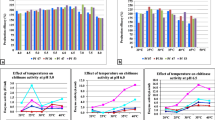Summary
The effects of a Pseudomonas fuscovaginae toxin, on germination, root formation and seedling elongation, after soaking rice grains in the toxin prior to sowing, was investigated. The toxin enhanced germination, but had no apparent effect on the number of roots of the seedlings. It induced a drastic inhibition of seedlings elongation correlated to varieties susceptibility to the disease in the rice field. After denaturation of the bioactive compounds of the extract, all the previously observed effects were lost. Using the toxin and the present test, could be a reliable tool for screening genotype susceptibility to P. fuscovaginae disease.
Similar content being viewed by others
References
Azegami K., K.Nishiyama, Y.Watanabe, T.Suzuki, M.Yoshida, K.Nose & S.Toda, 1985. Tropolone as a root growth-inhibitor produced by plant pathogenic Pseudomonas sp. causing seedling blight of rice. Ann. Phytopath. Soc. Jap. 51: 315–317.
Backmann P.A. & J.E.deVay, 1971. Studies on the mode of action and biogenesis of the phytotoxin syringomycin. Physiol. Plant Pathol. 1: 215–233.
Ballio A., F.Bossa, A.Collina, M.Gallo, N.S.Iacobellis, M.Paci, P.Pucci, A.Scaloni, A.Segre & M.Simmaco, 1990. Structure of syringotoxin, a bioactive metabolite of Pseudomonas syringae pv. syringae. FEBS Lett. 269: 377–380.
Che F.S., K.Kasama, N.Fukuchi, A.Isogai & A.Suzuki, 1992. Bacterial phytotoxins, syringomycin, syringostatin and syringotoxin, exert their effect on the plasma membrane H+-ATPase partly by a detergent-like action and partly by inhibition of the enzyme. Physiol. Plantarum 86: 518–524.
Deaton W.R., G.J.Keyes & G.G.Collins, 1982. Experessed resistance to black shank among tobacco callus cultures. Theor. Appl. Genet. 63: 65–75.
Detry J.F., 1990. Criblage variétal pour la résistance à Pseudomonas fuscovaginae au Burundi. p. 105–112. In: J.Bouharmont & J.P.Tilquin (Eds) Contraintes Liées à la Riziculture d'Altitude et Amélioration Variétale. UCL, Louvain-la-Neuve.
Detry J.F., E.Duveiller & H.Maraite, 1991. Mise au point d'une méthode d'évaluation de la résistance de cultivars de riz à Pseudomonas fuscovaginae. Parasitica 47: 151–163.
Duveiller E., K.Miyajima, F.Snaken, A.Autrique & H.Maraite, 1988. Characterisation of Pseudomonas fuscovaginae and differentiation from other fluorescent Pseudomonas occurring on rice i in Burundi. J. Phytopath. 122: 97–107.
Duveiller E., F.Snaken, H.Maraite & A.Autrique, 1989. First detection of Pseudomonas fuscovaginae on maize and sorghum in Burundi. Plant Dis. 73: 514–517.
Gonzalez C.F., J.E.DeVay & R.J.Wakeman, 1981. Syringotoxin: A phytotoxin unique to Citrus isolates of Pseudomonas syringae. Physiol. Plant Pathol. 18: 41–50.
Gross D.C., 1991. Molecular and genetic analysis of toxin production by pathovars of Pseudomonas syringae. Ann. Rev. Phytopath. 29: 247–278.
Gross D.C. & Y.S.Cody, 1985. Mechanisms of plant pathogenesis by Pseudomonas species. Can. J. Microbiol. 31: 403–410.
Cross D.C., J.E.DeVay & F.H.Stadtman, 1977. Chemical properties of syringomycin and syringotoxin: Toxigenic peptides produced by Pseudomonas syringae. J. Appl. Bacteriol. 43: 453–463.
Iacobelllis N.S., P.Lavermicocca, I.Grourina, M.Simmaco & A.Ballio, 1992. Phytotoxic properties of Pseudomonas syringae pv. syringae toxins. Physiol. Mol. Plant Path. 40: 107–116.
Maraite H., 1990. Protection integreé de la riziculture en marais d'altitude au Burundi. p. 138–149. In: J.Bouharmont & J.P.Tilquin (Eds) Contraintes Liées à la Riziculture d'Altitude et Amélioration Variétale. UCL, Louvain-la-Neuve.
Miyagima K., 1983. Studies on bacterial sheath brown rot of rice plant caused by Pseudomonas fuscovaginae Tanii, Miyagima & Akita. Report Hokkaido Prefecture Agricultural Experiment Station 43: 57–65.
Miyagima K., A.Tanii & T.Akita, 1983. Pseudomonas fuscovaginae sp. nov., nom. rev Int. J. Syst. Bacteriol. 33: 656–657.
Ntibishimirwa, M., 1991. Epidémiologie de la pourriture brune de la gaine foliaire du riz causée par Pseudomonas fuscovaginae au Burundi. Thesis, UCL, Louvain-la-Neuve.
Rine H.W. & H.H.Luke, 1985. Selection and regeneration of toxin-insensitive plants from tissue cultures of oats (Avena sativa) susceptible to Helminthosporium victoriae. Theor. Appl. Genet. 71: 16–21.
Rott P., J.Honegger, K.L.Notteghem & S.Ranomenjanahary, 1991. Identification of Pseudomonas fuscovaginae with biochemical, serological and pathogenicity tests. Plant Dis. 75: 843–846.
Surico G. & J.E.DeVay, 1982. Effect of syringomycin and syringotoxin produced by Pseudomonas syringae pv. syringae on structure and function of mitochondria isolated from holcus spot resistant and susceptible maize lines. Physiol. Plant Pathol. 21: 39–53.
Van denBulk R.W., 1991. Application of cell and tissue culture and in vitro selection for disease resistance breeding—a review. Euphytica 56: 269–285.
Willmot D.B., C.D.Nickell, J.M.Widholm & L.E.Gray, 1989. Evaluation of soybean resistance to Phialophora gregata culture filtrate in tissue culture. Theor. Appl. Genet. 77: 227–232.
Wolf S.J. & E.D.Earle, 1990. Inhibition of corn callus growth by Helminthosporium carbonum Race 1 toxin. Crop Sci. 30: 728–734.
Zhang L. & J.Y.Takemoto, 1986. Mechanism of action of Pseudomonas syringae phytotoxin, syringomycin-Interaction with the plasma membrane of wild-type and respiratory-deficient strains of Saccharomyces cerevisae. Biochem. Biophys. Acta 861: 201–204.
Author information
Authors and Affiliations
Rights and permissions
About this article
Cite this article
Batoko, H., Bouharmont, J. & Maraite, H. Inhibition of rice (Oryza sativa L.) seedling elongation by a Pseudomonas fuscovaginae toxin. Euphytica 76, 139–143 (1994). https://doi.org/10.1007/BF00024032
Received:
Accepted:
Issue Date:
DOI: https://doi.org/10.1007/BF00024032




